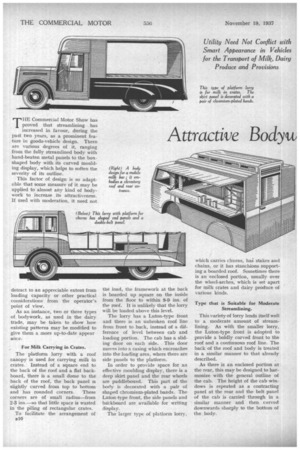Attractive Bodyw
Page 12

Page 13

If you've noticed an error in this article please click here to report it so we can fix it.
for the Dairy
ry HE Commercial Motor Show has proved that streamlining has increased in favour, during the past two years, as a prominent feature in goods-vehicle design. There are various degrees of it, ranging from the fully streamlined body with hand-beaten metal panels to the boxshaped body with its curved moulding display, which helps to soften the severity of its outline.
This factor of design is so adaptable that some measure of it may be applied to almost any kind of bodywork to increase its attractiveness. If used with moderation, it need not detract to an appreciable extent from loading capacity or other practical considerations from the operator's point of view.
As an instance, two or three types of bodywork, as used in the dairy trade, may be taken to show how existing patterns may be modified to give them a more up-to-date appear ance.
For Milk Carrying in Crates.
The platform lorry with a roof canopy is used for carrying milk in crates. InStead of a square end to the back of the roof and a flat backboard, there is a small dome to the back of the roof, the back panel is slightly curved from top to bottom and has rounded corners. These corners are of small radius—from 2-3 ins.—so that little space is wasted in the piling of rectangular crates.
To facilitate the arrangement of B10 the load, the framework at the back is boarded up square on the inside from the floor to within 8-9 ins, of the roof. It is unlikely that the lorry will be loaded above this level.
The lorry has a Luton-type front and there is an unbroken roof line from front to back, instead of a difference of level between cab and loading portion. The cab has a sliding door on each side. This door moves into a casing which encroaches into the loading area, where there are side panels to the platform.
In order to provide space for an effective moulding display, there is a deep skirt panel and the rear wheels are paddleboxed. This part of the body is decorated with a pair of shaped chromium-plated bands. The Luton-type front, the side panels and backboard are available for writing display.
The larger type of platform lorry,
which carries churns, haS. stakes and chains, or it has stanchions supporting a boarded roof. Sometimes there is an enclosed portion, usually over the wheel-arches, which is set apart for milk crates and dairy produce of various kinds.
Type that is Suitable for Moderate Streamlining.
This variety of lorry lends itself well to a moderate amount of streamlining. As with the smaller lorry, the Luton-type front is adopted to provide a boldly curved front to the roof and a continuous roof line. The back of the roof and body is treated in a similar manner to that already described.
As there is an enclosed portion at the rear, this may be designed to harmonize with the general outline of the cab. The height of the cab windows is repeated as a contracting panel at the rear and the belt panel of the cab is carried through in a similar manner and then curved downwards sharply to the bottom of the body.
The churn platform has full standing headroom, with rounded upper corners, and there is a central stanchion to support the roof and to provide a fastening for the inner ends of the rubber-covered chains.
The roofless platform lorry may be made more stylish by adding side panels at the front and rear, so that with a skirt board there is space for a curved moulding display. These end panels help to give rigidity to the front board and provide extra support for the rear stanchions if the lorry has a large tailboard.
Features of the Boxyan on House tohouseWork.
The boxvan, which is operated as a house-to-house delivery vehicle, has side panels, which slide behind fixed ones or swing from the top and push inwards under the roof. In other instances, roller shutters are mounted. During the round of calls, these panels and shutters are usually open, so that any streamlined display of mouldings embracing the whole of the side of the body is seldom seen.
As with the lorry, any special moulding display may be confined to the skirt panelling, or it may be extended to include the sides of the cab, if this be flush with the loading portion. Apart from this, there may be a display of curved moulding on the fixed side panelling at the rear, whilst the back of the body may be curved without interfering with the usual arrangement of stanchions and angle-iron runners which carry the crates.
A sidecar may be regarded as a boxvan in miniature. The main portion of the body has an upper and lower pair of angle-iron runners, each of which accommodates a pair of wire crates. This part of the body is about 3 ft. long, 2 ft. 3 ins, wide, and 2 ft. 3 ins, high, excluding the box, which is built on the roof to hold extended front is at the same level as the upper pair of runnerS, this part of the main portion of the body may be open in front, so that the trays are accessible either from the front or rear.
The Mobile Milk Bar.
The latest development of the dairy trade is the travelling milk bar. This may be similar ta the travelling shop, with a clerestory roof to provide adequate headroom inside, whilst one side of the body above the waist is hinged in two portions.
The upper portion, when suitably stayed, forms a canopy and the lower portion an extension of the inside counter. The equipment of the travelling milk bar includes an electric mixer, milk pump, milk tank, ite-cream container, refrigerator, etc.




























